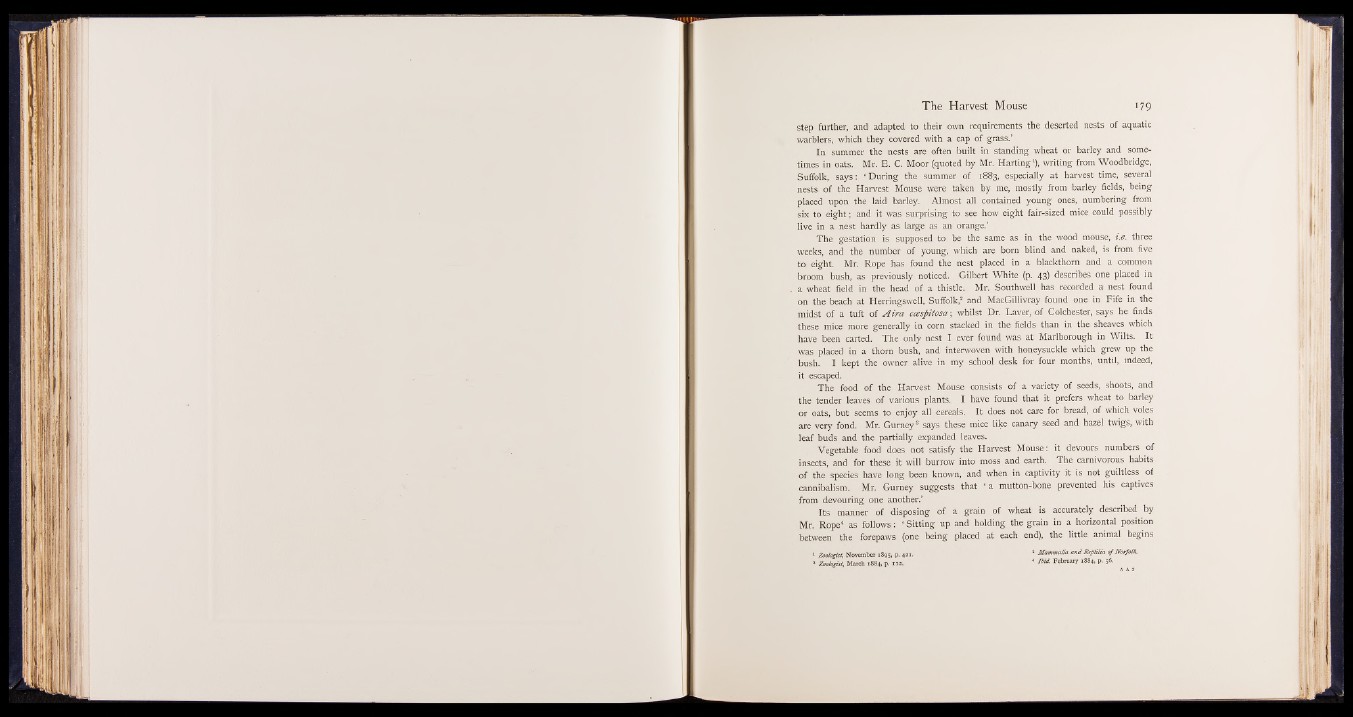
step further, and adapted to their own requirements the deserted nests of aquatic
warblers, which they covered with a cap of grass.’
In summer the nests are often built in standing wheat or barley and sometimes
in oats. Mr. E . C. Moor (quoted by Mr. Harting1), writing from Woodbridge,
Suffolk, say s : ‘ During the summer of 1883, especially at harvest time, several
nests of the Harvest Mouse were taken by me, mostly from barley fields, being
placed upon the laid barley. Almost all contained young ones, numbering from
six to eight; and it was surprising to see how eight fair-sized mice, could possibly
live in a nest hardly as large as an orange.’
The gestation is supposed to be the same as in the wood mouse, i.e. three
weeks, and the number of young, which are born blind and naked, is from five
to eight. Mr. Rope has found the nest placed in a blackthorn and a common
broom bush, as previously noticed. Gilbert White (p. 43) describes one placed in
a wheat field in the head of a thistle. Mr. Southwell has recorded a nest found
on the beach at Herringswell, Suffolk,2 and MacGillivray found one in Fife in the
midst of a tuft of A ira caspitosa; whilst Dr. Laver, of Colchester, says he finds
these mice more generally in corn stacked in the fields than in the sheaves which
have been carted. The only nest I ever found was at Marlborough in Wilts. It
was placed in a thorn bush, and interwoven with honeysuckle which grew up the
bush. I kept the owner alive in my school desk for four months, until, indeed,
it escaped.
The food of the Harvest Mouse consists of a variety of seeds, shoots, and
the tender leaves of various plants. I have found that it prefers wheat to barley
or oats, but seems to enjoy all cereals. It does not care for bread, of which voles
are very fond. Mr. Gurney8 says these mice like canary seed and hazel twigs, with
leaf buds and the partially expanded leaves.
Vegetable food does not satisfy the Harvest Mouse: it devours numbers of
insects, and for these it will burrow into moss and earth. The carnivorous habits
of the species have long been known, and when in captivity it is not guiltless of
cannibalism. Mr. Gurney suggests that ‘ a mutton-bone prevented his captives
from devouring one another.’
Its manner of disposing of a grain of wheat is accurately described by
Mr. Rope4 as follows: * Sitting up and holding the grain in a horizontal position
between the forepaws (one being placed at each end), the little animal begins
1 Zoologist, November 1895, p. 421- * Mammalia and Reftilia o f Norfolk.
3 Zoologist, March 1884, p. 112 . 4 February 1884, p. 56-